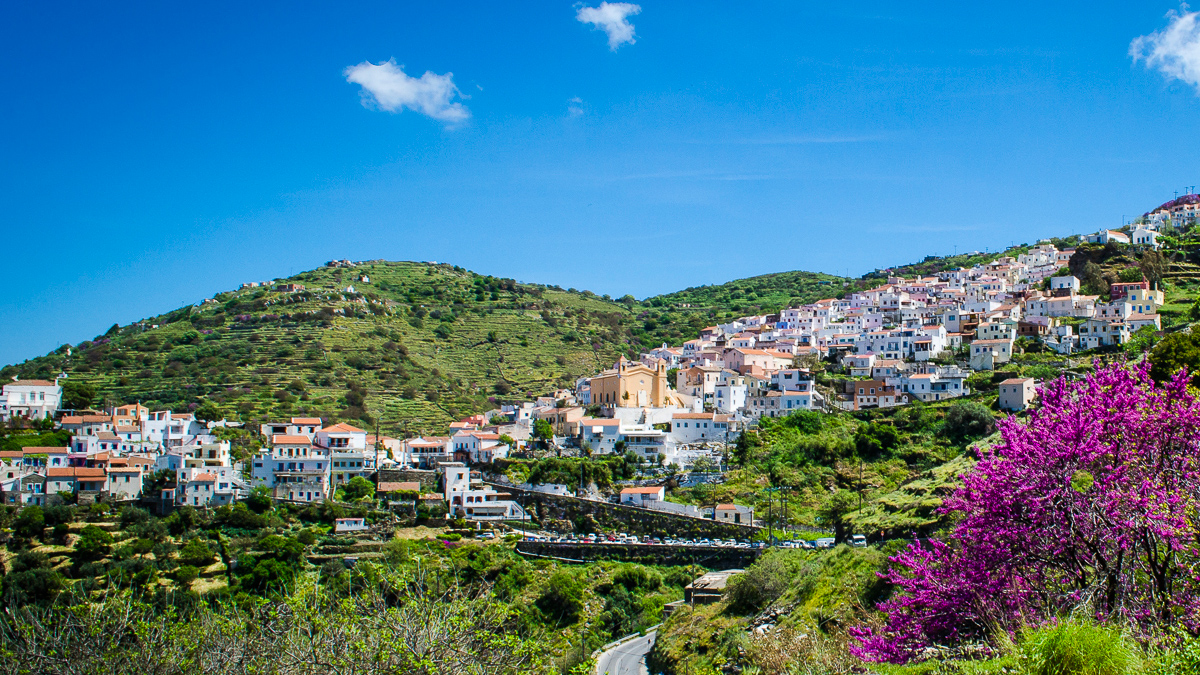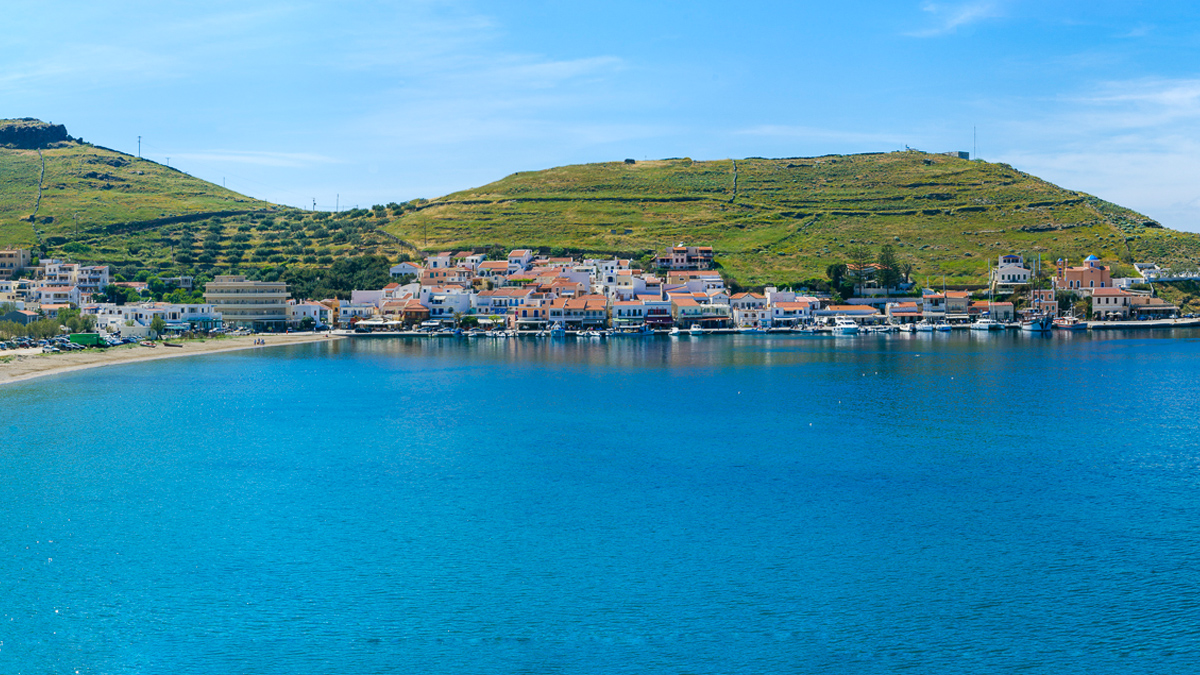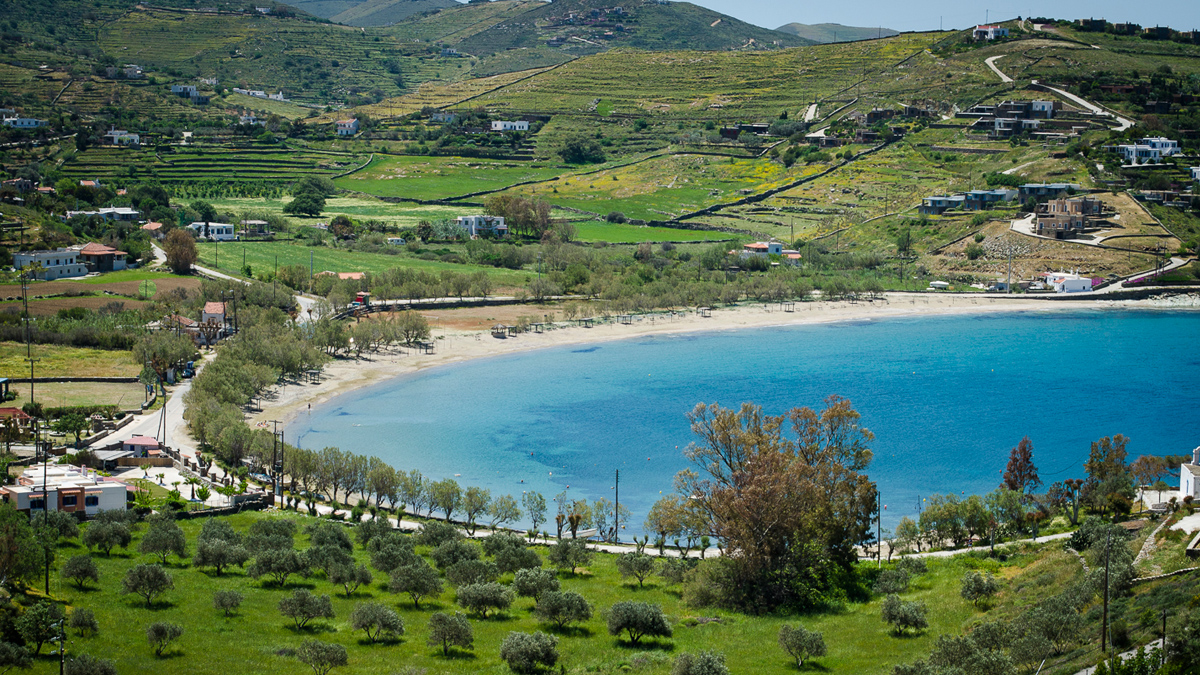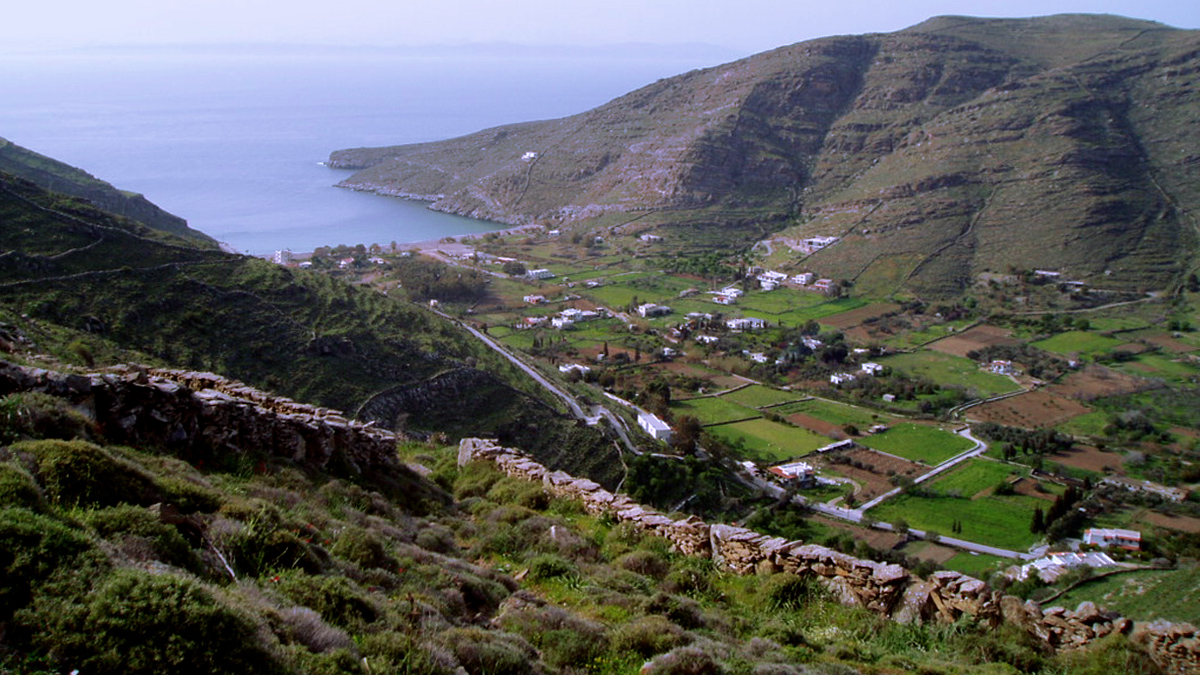Villages
Apart from the port of Korissia and Chora – Ioulida, Kea has four other villages where tourist island life focuses: Koundouros, Otzia, Vourkari and Pisses. Among them you will find smaller villages with less tourist traffic, such as Kato Meria.
As the boat approaches the port, in the background, you see Ioulis, the Chora of Kea, welcoming you spread on the top of the three hills. Ioulis is today’ s capital of Kea and a point of reference to the history of the island. Get ready for a walk in a fairytale village full of tightly built traditional white houses with reddish tile roofs, but also more recent multicolored houses, arches with “stegadia”, the typical Cycladic galleries, narrow stone-paved alleys with white landings, numerous chapels and disperse picturesque little shops.

How to go: From the port of Korissia by car spanning a distance of 5,5 km.
What to see:
The valley of Mylopotamos: On the route from Korissia to Ioulis, you will cross the valley of Mylopotamos, in the creek of which flows water from Ioulis and the rich spring of Flea, that ends up to Aghios Nikolaos bay and contributes to the dense vegetation of the area predominantly consisted of cypresses. Because of the abundance of water, 11 cereal-grinding watermills functioned in this area, typical samples of the local folk architecture, that today are in their majority abandoned or transformed into guesthouses.
The Piazza: When you arrive to Ioulis, after you leave your vehicle in the parking lot in front of the famous spring of Rokomenos –where the medical center of the island is hosted- you will ascend to Chora. In Piazza square where is the parking space for buses and taxis, you will meet the first shops and taverns. A narrow picturesque “stegadi” with artwork by famous painter –and honorary citizen of the island- Alekos Fasianos, invites you to pass through it and explore the four districts of contemporary and historic Ioulis.
The Medieval Castle: Kastro (Castle) district in the northwest took its name by the Venetian castle that was built in 1210 with building material from the temples of the ancient acropolis, as also happened with the houses of the district, many of which have embedded ancient reliefs. Today only a few of the parts from the ancient wall and the castle have survived and emerge in various spots. Here you will find the church of the patron saint of the island, Aghios Charalambos, who is royally honored on February 10th.
The Archeological Museum: On the incline from the Piazza towards the square of Chora, you will come across the Archaeological Museum. This is one of the most important museums in the Cyclades, with unique finds from excavations on the island, from the Neolithic period up until the historic period (7th B.C. – 2nd century A.D.). It has been open to the public since the 1970s, while in 2000 it was repaired and extended to welcome new exhibits. The exhibit sections have been organized into themes, covering daily life, worship and burial customs.
Architectural pieces, inscriptions, sculptures, votive reliefs, everyday objects, pottery and coins, provide a representative picture of the island’s history. Among them, highlights include the marble protocycladic figurines from the prehistoric settlement of Aghia Irini, the reliefs from the pediment of the temple of Athena at Karthaia and the headless statue of Victory. The renowned Kores, the clay statues of female figures of Aghia Irini, are exhibited in a prominent position in the new annexe, in an oblong curved showcase, giving the impression that are ready to dance.
The new & historic Town Hall: From Piazza, following the central road, you will meet Chora’ s square, where you can rest in one of the picturesque cafes and the taverns, find souvenirs and more presents and admire the Historic Town Hall, the architectural ornament of Chora. It is an impressive neoclassical building of 1902, work of Ernst Ziller, decorated with finds from the island’s various archeological sites. In its façade stand out the clay statues of Hermes and Apollo, while on the western side an ancient female sculpture and a relief of the classical era have been built into the wall. Inside the building more reliefs have been built into the walls while the conference room of the Municipal Council contains impressive ceiling paintings.
Close to the Tria Pigadia spring is located the new Town Hall of Ioulis, also based on Ziller’s designs. To admire it, you have to go down from Piazza towards the parking lot of Ioulis, just across it. In its 100-year life it hosted, among others, a Pre-Secondary School, a Secondary School and a High School. Today it is regarded as a building under preservation while recently it has been restored.
Katochori, Messada, Panochori: Ioulis, apart from the Castle, includes also Katochori, Messada and Panochori. In Catochori towers the cathedral of Ioulis, which is dedicated to the Annunciation of Virgin Mary and is also known as “Dimotikia”. At the east side of the village you find Messada district and around it Panochori district the highest part of Chora, where the church of Aghios Dimitrios is based.
The Mills: Ioulis, as the entire island, is surrounded by fields and orchards shaped on the slopes in terraces, in “ochtes” as the locals call them, defined by rocky walls, while its entire area is full of dispersed springs, with basins for the watering of animals. On the top of the Mills’ mountain you will see the biggest complex of windmills in Cyclades with 26 half-abandoned mills, that once upon a time were producing big amounts of barley, an indicative sample of folk architecture.
Korissia is the port of the island and the basic starting point for your excursions. It is located at the edge of a big natural bay, which makes it safe port.
The beautiful church of Aghia Trias is the first view you ‘ll have as soon as the boat’s hatch lowers. Livadi, as is also known Korissia, is a village built on the edges of the hill where ancient Korissos was located and it has traditional Cycladic architecture. Here you may find many shops, restaurants, cafes, bars and accommodations and a public parking lot.

How to go: It is the first spot you will find yourselves as soon as you disembark.
What to see
The village: As Korissia is built on the location of ancient Korissos, today, in the outskirts of the village, still survive the remains of ancient houses, a cemetery and a wall with towers on the hill of Aghios Savvas close to the church of Aghia Trias. There was also revealed the renowned Kouros of Kea, one of the most significant sculptures of the archaic times, that is exhibited at the National Archeological Museum.
The Enamel Factory: Inside the village of Korissia and on the way to Ioulis, you will meet the Enamel Factory, a significant monument of industrial heritage, the chimney of which is already noticeable as soon as the boat enters the port.
Ai Giorgis: At the end of the sandy beach, over the rock towers the picturesque church of Ai Giorgis that is impressively lit up every evening.
Just at a 2 km distance from Korissia, after Gialiskari, the coastal road will lead you in famous Vourkari, a small picturesque fish village that has developed the last years into a cosmopolitan town. In its closed and protected bay, you will see dozens of boats and sail boats anchored, while frequently end up here sailing races starting from Saronic Gulf. Taste some fresh fish, sea food and local delicacies in the beautiful taverns along the beach, take a walk το Aghia Irini, enjoy your drink or your coffee to the cafes and the bars and discover souvenirs and fine contemporary art works in the art galleries. Vourkari is a village that keeps pulsing day and night.

How to go: From the port of Korissia by car spanning a distance of 2 km.
What to see:
The peninsula of Aghia Irini: Just across Vourkari you will find the peninsula of Aghia Irini that took its name by the homonym picturesque chapel. Here, the excavations that were conducted in 1960 revealed one of the most important prehistoric settlement, which had been reconstructed multiple times after natural disasters; the result was that the architectural ruins of previous periods became the foundations for the next generations, creating a tight urban tissue, in which it’s difficult to identify the chronological relevance.
Here were found the only Temple of Dionysus of this period (2000 B.C.), a part of the fortification along with a tower and a gate (2000-1500 B.C.), the ruins of a sewer and a water supply network (15th century B.C.), “master’s mansion”, the ruins of a luxurious house built according to the Mycenaean standards (16th-15th century B.C.). The most impressive and internationally unique find are “Kores”, 50 clay figurines from the Late Bronze Age, that were discovered in the area of the temple and are assumed to be worshippers, priestesses or even goddesses. Today they are exhibited on a prominent position in the Archeological Museum of Ioulis, together with more finds of the area.
Kokka: Moving further to the narrow peninsula of Aghia Irini, you will find the abandoned area of Kokka. The previously industrial area was one of the most important location of coking coal replenishment for ships in Greece and a potent economic resource for the island. Today, the coal warehouses, the workers’ houses, which were built at the end of the 19th century and the main loading dock are abandoned in decay.
The strait of Lambros Katsonis: The most narrow point in the peninsula of Aghia Irini was the scenery for an adventurous episode from the modern Greek history: As the marble sign by Kean sculptor Giorgos Chionatos on the spot says, illustrious seafighter, Lambros Katsonis while serving the Russian Navy during the Russian-Turkish war (1787-1792), made Kea his base. After a gory battle with the unit of the Turkish fleet, in 1789, he was trapped in the port but he managed to escape during the night, passing with his boat in the Aegean through the narrow strait of Koka, with the help of the locals, who later unfortunately had to pay their devotion with slaughters and disasters.
The lighthouse of Aghios Nikolaos: The path from the strait of Lambros Katsonis leads to the lighthouse of Aghios Nikolaos that welcomes and says goodbye to the ships in its bay. It is built on the ruins of the sacred temple of Poseidon by the French Lighthouse Company, with a tower height of 8 m. and focal height 32 m., it is the first lighthouse that ever lit up in Cyclades in 1831 and the second one in Greece. It has been characterized as a monument, after the decision of the Ministry of Culture and tourism, as a “significant architectural construction and representative lighthouse sample”.
Kefala: North of the peninsula of Aghia Irini, you will find the location Kefala, another important archeological site. Here a rural settlement from the late Neolithic area was discovered, one of the earliest in Cyclades with the first organized –located outside the settlement- cemetery in the Aegean. The area is not easily accessible from land and it has a homonym beach. In Treis Ammoudies, the bay next to Kefala, have been built modern luxurious villas.
Otzias is one of the rapidly growing popular villages of Kea during the last years. It has a variety of accommodations and touristic businesses and is the ideal place for family vacation because its bay offers many alternative suggestions for swimming: a huge organized sandy beach and smaller bays around it.
How to go: From the port of Korissia by car spanning a distance of 5,5 km.

What to see:
The Monastery o Panagia Kastriani:
If you move at a distance of approximately 6 km northeast of Otzias beach, you will find yourselves in one of the most beautiful Greek monasteries, the Monastery of Panagia Kastriani, the protector of the island.
According to the Orthodox tradition, over the imposing hill Kastri with view to the big blue, Virgin Mary Herself “indicated” Her pilgrimage location. At that point, in 1700, shepherds, after following a shine in the sky, discovered her icon buried in the ground. There they built in 1708, a little chapel, where the holy icon is safeguarded until today, while in 1910 over this chapel was built a big church so that there is enough space for the large numbers of believers that swarm to worship Virgin Mary. She is honored several times in the course of year, but especially on August 15th. Moreover, the cells of the monastery function as guesthouses while in its dining room you will be offered local delicacies.
On the southwest side of Ioulis lay the fertile valley of Pisses reaching until the coast. One more picturesque and quiet village with rooms to let, a camping, super markets and taverns.

How to go: From Ioulida by car spanning a distance of 11 km southwest.
What to see:
In the ancient town of Poiiessa there are still traces of the fortification’s round tower, while in the south coast the premises of an ancient port have been discovered. Deep in the valley, you will see the little church of Aghios Isidoros, constructed of ancient building material. Enjoy the green landscape, the crystal waters of Pisses beaches and the sights.
The village of Koundouros, which in the ancient times was known as Nirissos, is one of the most developed touristic resorts of Kea. Here you will find restaurants and accommodations and, among others, restored stone windmills. A series of beaches in the area will fulfill every taste, either you are looking for a cosmopolitan beach, water sports, an anchorage for boats, or an isolated beach.
Where to go: From Ioulis by car spanning a distance of 16 km.

The village of Kato Meria is located in the inland of the island and is really worth a visit, if you want to discover one more face of Kea. Its few inhabitants are mainly farmers and life has either slow, not at all touristic rhythms. In Kato Meria you will find a beautiful stone-made square, a grocery store and a tavern.
How to go: From Ioulis by car spanning a distance of 14 km towards the south part of the island.
